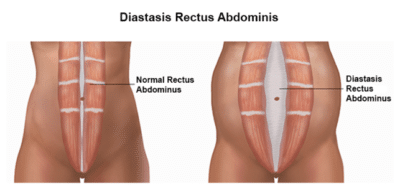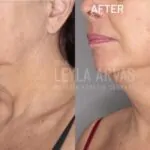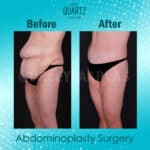 Diastasis recti is a condition that affects the abdominal muscles. The rectus abdominis muscles run vertically on either side of the midline of the abdomen and are separated by a connective tissue called the linea alba. While diastasis recti often resolves on its own within a few months after delivery, some individuals may require Diastasis Recti Treatment to improve the condition.
Diastasis recti is a condition that affects the abdominal muscles. The rectus abdominis muscles run vertically on either side of the midline of the abdomen and are separated by a connective tissue called the linea alba. While diastasis recti often resolves on its own within a few months after delivery, some individuals may require Diastasis Recti Treatment to improve the condition.
In individuals with diastasis recti, the connective tissue weakens and stretches, causing the muscles to separate and creating a gap. This gap can range from a few millimeters to several centimeters, depending on the severity of the condition.
abdominal separation is most commonly seen in women after pregnancy, but it can occur in anyone, including men and children. Factors that increase the risk of developing diastasis recti include obesity, age, multiple pregnancies, and increased abdominal pressure (such as heavy lifting or chronic coughing).
abdominal separation symptoms
abdominal separation symptoms can include a bulge or “pooch” in the abdominal area, back pain, weakness in the core, and difficulty with tasks that require a strong core, such as sit-ups.
Treatment for diastasis recti typically involves diastasis recti physical therapy exercise to strengthen the abdominal muscles and improve core stability. These exercises may include targeted abdominal exercises, pelvic floor muscle exercises, and postural correction exercises. In some cases, surgery may be recommended if the separation is severe or does not respond to conservative treatments.
It’s important to work with a doctor to properly diagnose and treat diastasis recti, as it can impact quality of life and physical function.
How is Diastasis Recti Treatment Done?
- abdominal separation physical exercise
Diastasis recti treatment typically involves diastasis recti physical therapy exercises to strengthen the abdominal muscles and improve core stability. The following are some common components of a physical therapy program for diastasis recti; Abdominal muscle strengthening exercises, pelvic floor muscle exercises, postural correction exercises, manual therapy.
In some cases, surgery may be recommended if the separation is severe or does not respond to conservative treatments. It’s important to work with a qualified aesthetic surgeon to develop an individualized treatment plan, as not all exercises and treatments are appropriate for everyone.
- Surgical intervention
Diastasis Recti Treatment by an aesthetic surgeon typically involves a surgical procedure known as an abdominal plication or tummy tuck. This procedure involves making an incision in the lower abdomen, tightening the separated abdominal muscles, and removing excess skin and fat. The goal of the surgery is to restore the abdominal muscles to their normal position and improve the appearance of the midsection. This can help improve core stability, reduce bulging, and create a smoother and more toned abdominal appearance.
It’s important to note that abdominal plication surgery is a major procedure that carries risks and complications, including bleeding, infection, and dissatisfaction with the results. Additionally, it’s important to address any underlying contributing factors, such as obesity or poor posture, in order to achieve optimal results.
Before considering Diastasis Recti Treatment surgery, it’s important to discuss all treatment options with a qualified doctor, including the risks, benefits, and expected outcomes. In many cases, conservative treatments, such as diastasis recti physical therapy, can be effective in improving the symptoms of diastasis recti. However, if surgery is the best option, it’s important to choose a qualified and experienced aesthetic surgeon who has a good track record of successful outcomes.
How is Diastasis Recti Diagnosed?
Diastasis recti is typically diagnosed by a physical examination. During the examination, the doctor will assess the separation of the rectus abdominis muscles and the extent of the gap. The following steps may be used to diagnose diastasis recti:
- Visual inspection: The doctor will visually inspect the abdominal area for a bulge or “pooch” that may indicate a separation of the rectus abdominis muscles.
- Palpation: The doctor will use their hands to feel for a separation in the abdominal muscles.
- Measurement: The doctor may use a measuring tape to determine the size of the gap between the rectus abdominis muscles.
- Testing: The doctor may ask the individual to perform specific movements, such as a sit-up, to assess for any changes in the gap between the rectus abdominis muscles.
If diastasis recti is suspected, it’s important to seek medical attention to determine the best course of treatment. Early diagnosis and treatment can help prevent or improve symptoms and improve overall quality of life.
 What Should be Considered the Diastasis Recti Treatment?
What Should be Considered the Diastasis Recti Treatment?
When considering the Diastasis Recti Treatment, the following factors should be considered:
- Severity of the condition: The severity of the condition will play a role in determining the most appropriate course of Diastasis Recti Treatment.
- In some cases, conservative treatments, such as physical therapy or exercise, may be effective in improving the condition, while in other cases, surgery may be necessary.
- Health history: The individual’s overall health and medical history should be taken into consideration when determining the most appropriate course of Diastasis Recti Treatment.
- Lifestyle: The individual’s lifestyle, including their level of physical activity, will also play a role in determining the most appropriate course of Diastasis Recti Treatment.
- Personal preferences: The individual’s personal preferences, including their desire for a non-surgical or surgical approach, should also be taken into consideration.
- Doctor experience: The experience and qualifications of the doctor should also be considered when choosing a course of treatment.
How Much Does abdominal separation surgery cost in Istanbul, Turkey?
The abdominal separation surgery cost treatment can vary widely depending on a number of factors, including the type of procedure, the experience of the surgeon, and the location. It’s important to note that the abdominal separation surgery cost can vary widely depending on the extent of the procedure, the experience of the surgeon, and the location.
Additionally, the cost of diastasis recti surgery can include prices for the surgeon, the anesthesia, the clinic, the hospital and any pre- or post-operative care. It’s also important to choose a qualified and experienced surgeon who has a good track record of successful outcomes and to discuss all treatment options, including the risks, benefits, and costs, before making a decision. You can learn your price information in the most accurate way at the end of the examination.
For Ministry of Health-accredited centers, it is not legal to specify prices on their website. Therefore, please dial 0212 241 46 24 to contact Quartz Clinique and get information on Diastasis Recti Treatment Prices In ISTANBUL, TURKEY.












